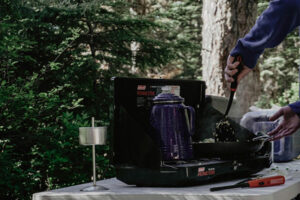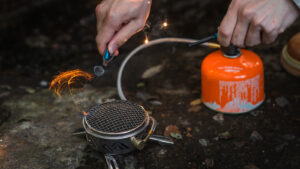
Moreover, it is crucial to note that the multi-canister-compatible stove can use different types of butane, propane, and isobutane canisters. This makes it one size fits all for travelers going on many trips in short duration since they can always refill gas while traveling.
On the other hand, liquid fuels are always useful when camping in harsh weather conditions. Just weigh their advantages against disadvantages as this will go a long way into helping you select from any one of these two types. Below we will closely look at each kind with its strengths and weaknesses.
Multi-Canister Stove vs Liquid Fuel Stove for Backpacking: Pros and Cons
Deciding whether to carry along a multi-canister stove or go with a liquid fuel one for your backpacking adventure will require deeper assessment of their strong points and weak points which makes choosing between them difficult. We have some thoughts about them:
Pros of Multi-Canister Stove
- Versatility: Many options such as butane, propane, iso-butane fuels.
- Ease of Use: The user-friendliness associated with using these cannot be compared to anything else.
- Lightweight: These tend to be more lightweight compared to others, making them ideal for those who like being light while backpacking.
Multi-Canister Stove: Cons
- Fuel Availability: Canisters may not be found everywhere. This becomes a problem in remote areas.
- Cold Weather Performance: In extremely cold temperatures, canister stoves can face problems. Gas fuel loss in canisters results from pressure drops.
- Cost: Over time, they turn out to be more expensive than liquid fuel. Regular replacements are costly.
- Waste: Empty cans add up and require proper disposal and recycling.
 Liquid Fuel Stove: Pros
Liquid Fuel Stove: Pros
- Fuel Availability: Liquid fuel is easily accessible. It’s available worldwide in most places across the earth.
- Cold Weather Performance: These stoves perform well in cold weather conditions. No gas leaks from them, even when they are operated at low environmental temperatures.
- Refillable: Liquid fuel bottles are returnable. This means one does not have to keep on throwing it away, as it will not create any waste but instead help save the environment through its eco-friendliness.
- Cost-effective: Over the long run, liquid fuel is less expensive. Rather than canisters, large bottles last for quite some time.
Liquid Fuel Stove: Cons
- Complexity: They tend to be more intricate compared with those using solid fuels. So priming and periodic maintenance are needed for them to work properly eventually.
- Weight: These stoves and their fuels weigh more than other types of stoves. However, this may be disadvantageous to light-backpacking, hence it is avoided at all costs by these hikers.
- Soot and Smell: Burning liquid fuel has been known to cause soot formation, which is messy, whereas there is always an associated pungent smell with its combustion process.
- Spill Risk: There is danger of spilling the fluid fuel if it is mishandled or kept wrongly.
The type of stove you decide on will depend entirely upon your intended use. Multifuel canister stoves are even more foolproof and lightweight. You can buy liquid fuel stoves if your goal is reliability in extreme conditions, as well as price. Before choosing your stove make sure to have a look at the weather of your destination.
Can a Multi-Canister Stove Use Isobutane, Propane, and Butane Canisters?
Yes, a multi-canister compatible stove can use isobutane, propane, and butane as a fuel. They are versatile cooking appliances. The performance of isobutane in cold conditions has made it a popular choice. Propane provides a high heat output, which makes it very good for fast food preparation. Butane is light and small in size, making it suitable for short trips.
Check the valve and regulator on your stove to determine compatibility with each type of fuel you use. In order to choose the right adapter that suits the available fuel type as well as trip demand, one needs to do a lot of research on various fuel types before deciding on one specific kind. For these reasons, multi-canister stoves have become reliable options for many camping situations, improving outdoor experiences.
 Maintenance Tips for a Multi-Canister Compatible Stove
Maintenance Tips for a Multi-Canister Compatible Stove
To be able to keep them working for a long time and in an energy-efficient manner, it is important that you properly maintain your multi-canister compatible stove. Below are some essential hints:
- Cleaning Regularly: Clean the burner after every use. Ensure that all food remnants have been removed from it and that it is free of dirt that could block its flow.
- Check Connections: Check the connection between the gas canister and stove for any leaks. Test using soapy water; bubbles indicate leakage.
- Keep O-Rings Lubricated: Sometimes, lubricate the O-rings on the stove connections. The use of silicone grease keeps them supple and prevents cracking.
- Storage: Keep your stove in a dry place whenever it is not being used; use a case or bag to prevent dust from affecting parts.
- Fuel Used Should Be Right: Try as much as possible to use the right fuel, like propane, butane, or isobutene, because these will avoid damage and ensure performance enhancement.
- Follow what manufacturers say: adhere to maintenance guidelines provided by stove manufacturers.
By following these maintenance tips, your multi-canister stove will remain reliable and efficient, ready for any camping adventure. Proper care enhances safety and extends the life of your equipment, ensuring a hassle-free experience outdoors.
Conclusion
The right stove selection is paramount when backpacking. Multi-canister stoves are very safe to use and user-friendly, while the liquid gas stove works well in cold weather. Each has its strengths or weaknesses, which depend on what you desire and your location.
After knowing the strong and weak aspects of them all, making a knowledgeable decision while going out will make it safe for your trip. Appropriate care of your stove combined with the correct choice of fuel will make your backpacking experience more enjoyable.

 Liquid Fuel Stove: Pros
Liquid Fuel Stove: Pros Maintenance Tips for a Multi-Canister Compatible Stove
Maintenance Tips for a Multi-Canister Compatible Stove







